Federated Digital Platforms: Value Chain Integration for Sustainable Infrastructure Planning and Delivery
Abstract
:1. Introduction
1.1. The Context of the Sutainable Infrastructure Challenge
1.2. Structure of the Article and Approach to Solution
- The individual internal perspective (human-centered),i.e., the needs-based perspective of direct and indirect users of infrastructure objects (subway, water supply, etc.);
- The individual external perspective (technology-enabled),i.e., the required competencies of all persons involved in the planning and implementation process;
- The collective internal perspective (culture-embracing),i.e., the consideration of cultural aspects in infrastructure development;
- The collective external perspective (system-thinking),i.e., the adaptation of planning to all legal and technical regulations.
1.3. Policy and Governance of Infrastructure Development and Delivery
2. Methodical Approach
3. Outcome of the Expert Interviews, Workshops, and Literature Assessment
- A well-articulated vision for infrastructure that enables a systematic development of a robust pipeline of bankable projects and long-term plans with robust business cases;
- Strong project governance arrangements to enable strong project delivery including a more agile set of regulations to reflect optimal practice embracing new infrastructure technologies;
- The careful management of societal and environmental impacts to support project delivery. An early and thorough multi-stakeholder participation minimizes risks and maximizes positive overall outcome. Risk transfer needs to be carried out appropriately to maintain value for money;
- A procurement model chosen on the basis of project specifics and rigorously following established published guidelines.
4. Proposal of Federated Digital Platform for Sustainable Infrastructure
4.1. Mobilization and Learning Platforms for Infrastructure
4.2. Analysis of the Five Dimensions
4.2.1. Governance
- Avoid “lock-in” to a particular technology, with resulting technological and commercial dependency on the provider;
- Reduce the risk of services being modified or terminated in an uncoordinated manner by the provider;
- Share selected data and digital services to different ecosystems, while ensuring ownership, data, and privacy protection;
- Gain access to open and trusted data spaces to maintain control over the development of new digital services within an interoperable and trustworthy digital and data infrastructure.
4.2.2. Design
4.2.3. Protocols
4.2.4. Implementation
4.2.5. Use Cases
- Organizing digital public consultation processes;
- Supporting a digital permitting process, e.g., for building permits;
- Enhancing urban planning considering climate resilience functions;
- Enabling generative, parametric, and collaborative design;
- Provision of unstructured data mining tools to support the infrastructure planning and delivery process including real-time work-site monitoring and management decision-making;
- Ensuring seamless flow of information during project development and planning phase;
- Transparent project delivery, e.g., project controlling, including risk monitoring and ESG controlling functions;
- New technologies for commercial processes;
- Provision of “Design-Construct-O&M (Operate and maintain)”-as-a-Service.
5. Conclusions and Outlook
Author Contributions
Funding
Institutional Review Board Statement
Informed Consent Statement
Acknowledgments
Conflicts of Interest
Appendix A
References
- Munyasya, B.M.; Chileshe, N. Towards sustainable infrastructure development: Drivers, barriers, strategies, and coping mechanisms. Sustainability 2018, 10, 4341. [Google Scholar] [CrossRef] [Green Version]
- Loorbach, D. Transition management for sustainable development: A prescriptive, complexity-based governance framework. Governance 2010, 23, 161–183. [Google Scholar] [CrossRef]
- Vares, H.; Parvandi, Y.; Ghasemi, R.; Abdollahi, B. Transition from an efficiency-driven economy to innovation-driven: A secondary analysis of countries global competitiveness. Eur. J. Econ. Financ. Adm. Sci. 2011, 31, 124–132. [Google Scholar]
- Tan, K.-S.; Phang, S.-Y. From Efficiency-Driven to Innovation-Driven Economic Growth: Perspectives from Singapore; World Bank Publications: Herndon, VA, USA, 2005; Volume 3569. [Google Scholar]
- Schwab, R.; Zahidi, S.; World Economic Forum. The Global Competitiveness Report. Special Edition 2020: How Countries are Performing on the Road to Recovery; WEF: Geneva, Switzerland, 2020. [Google Scholar]
- Rowley, A.H. Foundations of The Future: The Global Battle for Infrastructure; World Scientific: Toh Tuck Link, Singapore, 2020. [Google Scholar]
- Ramamurti, R.; Doh, J.P. Rethinking foreign infrastructure investment in developing countries. J. World Bus. 2004, 39, 151–167. [Google Scholar] [CrossRef]
- Cantarelli, C.C.; Flyvbjerg, B.; van Wee, B.; Molin, E.J.E. Cost overruns in large-scale transportation infrastructure projects: Which explanations can be given? In Proceedings of the 2008 First International Conference on Infrastructure Systems and Services: Building Networks for a Brighter Future (INFRA), Rotterdam, The Netherlands, 10–12 November 2008. [Google Scholar]
- Flyvbjerg, B.N.; Bruzelius, N.; Rothengatter, W. Megaprojects and Risk: An Anatomy of Ambition; Cambridge University Press: Cambridge, UK, 2003. [Google Scholar]
- Flyvbjerg, B.; Holm, M.K.S.; Buhl, S.L. What causes cost overrun in transport infrastructure projects? Transp. Rev. 2004, 24, 3–18. [Google Scholar] [CrossRef] [Green Version]
- Flyvbjerg, B. Policy and Planning for Large-Infrastructure Projects: Problems, Causes, Cures. Environ. Plan. B Plan. Des. 2007, 34, 578–597. [Google Scholar] [CrossRef] [Green Version]
- Tallberg, J.; Zürn, M. The legitimacy and legitimation of international organizations: Introduction and framework. Rev. Int. Organ. 2019, 14, 581–606. [Google Scholar] [CrossRef] [Green Version]
- G20. About the G20, G20 website. 2021. Available online: https://www.g20.org/about-the-g20.html (accessed on 5 August 2021).
- Ougaard, M. The transnational state and the infrastructure push. New Political Econ. 2018, 23, 128–144. [Google Scholar] [CrossRef]
- GIHub. Forecasting Infrastructure Investement Needs and Gaps. G20 Global Infrastructure Outlook 2021. Available online: https://outlook.gihub.org/ (accessed on 30 April 2021).
- GIHub. Global Infrastructure Hub—A G20 Initiative. 2021. Available online: https://www.gihub.org/ (accessed on 2 August 2021).
- OECD. OECD Infrastructure Working Group (IWG). 2021. Available online: https://www.oecd.org/g20/topics/infrastructure/ (accessed on 2 August 2021).
- WEF. WEF Infrastructure Initiatives. 2021. Available online: https://www.weforum.org/projects/infrastructure-4-0 (accessed on 2 August 2021).
- Bielenberg, A.; Kerlin, M.; Oppenheim, J.; Roberts, M. Financing Change: How to Mobilize Private-Sector Financing for Sustainable Infrastructure; McKinsey Center for Business and Environment: London, UK, 2016; pp. 24–25. [Google Scholar]
- Cuttaree, V.; Mandri-Perrott, X.C. Public-Private Partnerships in Europe and Central Asia: Designing Crisis-Resilient Strategies and Bankable Projects; World Bank Publications: Herndon, VA, USA, 2011. [Google Scholar]
- Wilber, K. Integral Politics: Its Essential Ingredients—Integral Life. 2018. Available online: https://integrallife.com/integral-politics-its-essential-ingredients/ (accessed on 2 August 2021).
- World Bank. Infratech Value Drivers. 2020. Available online: https://openknowledge.worldbank.org/handle/10986/34320 (accessed on 2 August 2021).
- World Bank. Infratech Policy Toolkit. 2020. Available online: https://openknowledge.worldbank.org/handle/10986/34326 (accessed on 2 August 2021).
- G20 Infrastructure Working Group. G20 Riyadh InfraTech Agenda, G.I.W. 2020. Available online: https://cdn.gihub.org/umbraco/media/3008/g20-riyadh-infratech-agenda.pdf (accessed on 2 August 2021).
- Döringer, S. ‘The problem-centred expert interview’. Combining qualitative interviewing approaches for investigating implicit expert knowledge. Int. J. Soc. Res. Methodol. 2020, 24, 265–278. [Google Scholar] [CrossRef]
- Ochieng, E.; Price, A.; Moore, D. Major Infrastructure Projects: Planning for Delivery; Palgrave Macmillan: London, UK, 2017. [Google Scholar]
- Department of Infrastructure and Transport. Infrastructure Planning and Delivery: Best Practice Case Studies; Department of Infrastructure and Transport: Canberra, Australia, 2012; Volume 2. [Google Scholar]
- Narayanaswami, S. Urban transportation: Innovations in infrastructure planning and development. Int. J. Logist. Manag. 2017, 28, 150–171. [Google Scholar] [CrossRef]
- Mell, I.; Allin, S.; Reimer, M.; Wilker, J. Strategic green infrastructure planning in Germany and the UK: A transnational evaluation of the evolution of urban greening policy and practice. Int. Plan. Stud. 2017, 22, 333–349. [Google Scholar] [CrossRef] [Green Version]
- Wilker, J.; Rusche, K.; Rymsa-Fitschen, C. Improving participation in green infrastructure planning. Plan. Pr. Res. 2016, 31, 229–249. [Google Scholar] [CrossRef]
- Hislop, M.; Scott, A.J.; Corbett, A. What does good green infrastructure planning policy look like? Developing and testing a policy assessment tool within Central Scotland UK. Plan. Theory Pract. 2019, 20, 633–655. [Google Scholar] [CrossRef]
- Sinnett, D.; Smith, N.; Burgess, S. Handbook on Green Infrastructure: Planning, Design and Implementation; Edward Elgar Publishing: Cheltenham, UK, 2015. [Google Scholar]
- Fellows, R.; Liu, A.M. Managing organizational interfaces in engineering construction projects: Addressing fragmentation and boundary issues across multiple interfaces. Constr. Manag. Econ. 2012, 30, 653–671. [Google Scholar] [CrossRef] [Green Version]
- Benington, H.D. Production of large computer programs. Ann. Hist. Comput. 1983, 5, 350–361. [Google Scholar] [CrossRef]
- Allee, V. The Future of Knowledge; Taylor & Francis: Oxfordshire, UK, 2009. [Google Scholar]
- Moser, H. Barriers to Bankable Infrastructure: Incentivizing Private Investment to Fill the Global Infrastructure Gap; Rowman & Littlefield: Lanham, MD, USA, 2016. [Google Scholar]
- Hein, A.; Schreieck, M.; Riasanow, T.; Setzke, D.S.; Wiesche, M.; Böhm, M.; Krcmar, H. Digital platform ecosystems. Electron. Mark. 2020, 30, 87–98. [Google Scholar] [CrossRef] [Green Version]
- Samans, R.; Davis, N.; World Economic Forum. Advancing Human-Centred Economic Progress in the Fourth Industrial Revolution. A Leadership Agenda for G20 Governments; WEF: Geneva, Switzerland, 2017. [Google Scholar]
- ElMassah, S.; Mohieldin, M. Digital transformation and localizing the Sustainable Development Goals (SDGs). Ecol. Econ. 2020, 169, 106490. [Google Scholar] [CrossRef]
- Anumba, C.J.; Roofigari-Esfahan, N. Cyber-Physical Systems in the Built Environment; Springer: Manhattan, NY, USA, 2020. [Google Scholar]
- Hetemi, E.; Ordieres-Meré, J.; Nuur, C. An Institutional Approach to Digitalization in Sustainability-Oriented Infrastructure Projects: The Limits of the Building Information Model. Sustainability 2020, 12, 3893. [Google Scholar] [CrossRef]
- Hagel, J. The Power of Platforms: Part of the Business Trends Series; Deloitte University Press: Westlake, TX, USA, 2015. [Google Scholar]
- Hagel, J.; Brown, J.S. From Push to Pull: Emerging Models for Mobilizing Resources. J. Serv. Sci. 2008, 1, 93–110. [Google Scholar] [CrossRef] [Green Version]
- Hagel, J.; Brown, J.S. Shaping Strategies for the IoT. Computer 2017, 50, 64–68. [Google Scholar] [CrossRef]
- Hagel, J. John Hagel’s Personal Website. 2021. Available online: https://www.johnhagel.com/category/learning/ (accessed on 10 March 2021).
- Passos, D.S.; Coelho, H.; Sarti, F.M. From Resilience to the Design of Antifragility. In Proceedings of the PESARO 2018: The Eighth International Conference on Performance, Safety and Robustness in Complex Systems and Applications, Athens, Greece, 22–26 April 2018. [Google Scholar]
- Taleb, N.N. Antifragile: Things That Gain from Disorder; Random House Trade Paperback: New York, NY, USA, 2014; 519p. [Google Scholar]
- Sawhney, A.; Riley, M.; Irizarry, J. Construction 4.0: An Innovation Platform for the Built Environment; Routledge: Abingdon, UK; New York, NY, USA, 2020. [Google Scholar]
- Jelinek, T.; Wallach, W.; Kerimi, D. Policy brief: The creation of a G20 coordinating committee for the governance of artificial intelligence. AI Ethics 2020, 1, 141–150. [Google Scholar] [CrossRef]
- Jelinek, T. The artificial intelligence governance gap. In Intelligent Decarbonisation: Can Artificial Intelligence and Cyber-Physical Systems Foster the Achievement of Climate Mitigation Targets; Inderwildi, O., Kraft, M., Eds.; Springer Nature: Cham, Switzerland, 2021. [Google Scholar]
- OECD. Getting Infrastructure Right: The Ten Key Governance Challenges and Policy Options. The OECD Framework for the Governance of Infrastructure; OECD: Paris, France, 2017. [Google Scholar]
- WEF. Agile Regulation for the Fourth Industrial Revolution: A Toolkit for Regulators; World Economic Forum: Geneva, Switzerland, 2020. [Google Scholar]
- Kenny, C. Infrastructure Governance and Corruption: Where Next; World Bank Publications: Herndon, VA, USA, 2007; Volume 4331. [Google Scholar]
- Anan, H.; Tang, J.; Maly, K.; Nelson, M.; Zubair, M.; Yang, Z. Challenges in building federation services over harvested metadata. In Proceedings of the International Conference on Asian Digital Libraries (ICADL), Kuala Lumpur, Malaysia, 8–12 December 2003. [Google Scholar]
- Silva, J.d.C.; Rodrigues, J.J.P.C.; Al-Muhtadi, J.; Rabelo, R.A.L.; Furtado, V. Management platforms and protocols for internet of things: A survey. Sensors 2019, 19, 676. [Google Scholar] [CrossRef] [Green Version]
- Fischer, M.; Ashcraft, H.; Reed, D.; Khanzode, A. Integrating Project Delivery; John Wiley & Sons: Hoboken, NJ, USA, 2017. [Google Scholar]
- Raj, P.; Raman, A.C. The Internet of Things: Enabling Technologies, Platforms, and Use Cases; CRC Press: Boca Raton, FL, USA, 2017. [Google Scholar]
- Zhang, L.; He, J.; Zhou, S. Sharing tacit knowledge for integrated project team flexibility: Case study of integrated project delivery. J. Constr. Eng. Manag. 2013, 139, 795–804. [Google Scholar] [CrossRef]
- West, M. The Approach to Develop the Foundation Data Model for the Information Management Framework. In National Digital Twin Programme; Centre for Digital Built Britain: Cambridge, UK, 2021. [Google Scholar]
- Smith, P. BIM Implementation—Global Strategies. Procedia Eng. 2014, 85, 482–492. [Google Scholar] [CrossRef] [Green Version]
- Kent, D.C.; Becerik-Gerber, B. Understanding construction industry experience and attitudes toward integrated project de-livery. J. Constr. Eng. Manag. 2010, 136, 815–825. [Google Scholar] [CrossRef]
- Lloyd-Walker, B.M.; Mills, A.J.; Walker, D.H. Enabling construction innovation: The role of a no-blame culture as a collabo-ration behavioural driver in project alliances. Constr. Manag. Econ. 2014, 32, 229–245. [Google Scholar] [CrossRef]
- Ostrom, E. Governing the Commons: The Evolution of Institutions for Collective Action; Cambridge University Press: Cambridge, UK, 1990. [Google Scholar]
- Siddarth, D.E.G.W. The Case for the Digital Commons; World Economic Forum: Geneva, Switzerland, 2021. [Google Scholar]
- Kroner, R.G.; Barbier, E.B.; Chassot, O.; Chaudhary, S.; Cordova, L.; Cruz-Trinidad, A.; Cumming, T.; Howard, J.; Said, C.K.; Kun, Z.; et al. COVID-era policies and economic recovery plans: Are governments building back better for protected and conserved areas? Park 2021, 27, 135–148. [Google Scholar] [CrossRef]
- Bricout, J.; Baker, P.M.A.; Moon, N.W.; Sharma, B. Exploring the smart future of participation: Community, inclusivity, and people with disabilities. Int. J. E Plan. Res. 2021, 10, 94–108. [Google Scholar] [CrossRef]
- Elkington, J. Enter the triple bottom line. In The Triple Bottom Line: Does It All Add Up; Henriques, A., Richardson, J., Eds.; Routledge: Oxfordshire, UK, 2004. [Google Scholar]
- Mukhopadhyay, S.; Bouwman, H. Orchestration and governance in digital platform ecosystems: A literature review and trends. Digit. Policy Regul. Gov. 2019, 21, 329–351. [Google Scholar] [CrossRef]
- Soto, J.C.; Kyt, W.; Jahn, M.; Pullmann, J.; Bonino, D.; Pastrone, C.; Spirito, M. Towards a Federation of Smart City Services. In Proceedings of the International Conference on Recent Advances in Computer Systems, Hail, Saudi Arabia, 30 November–1 December 2015. [Google Scholar]
- World Economic Forum. Shaping the Future of Construction—Inspiring Innovators Redefine the Industry; WEF: Geneva, Switzerland, 2017. [Google Scholar]
- Paruchuri, V.K. Adaptive Scalable Protocols for Heterogeneous Wireless Networks. Ph.D. Dissertation, Louisiana State University, Baton Rouge, LA, USA, August 2006. [Google Scholar]
- Gritsenko, D.; Wood, M. Algorithmic governance: A modes of governance approach. Regul. Gov. 2020. [Google Scholar] [CrossRef]
- Jelinek, T. The future rulers? On artificial intelligence ethics and governance. In Reset Europe: Time for Culture to Give Europe New Momentum; Billows, W., Körber, S., Eds.; Institut für Auslandsbeziehungen (IFA): Stuttgart, Germany, 2020; pp. 244–252. [Google Scholar]
- Howell, G.; Ballard, G.; Demirkesen, S. Why lean projects are safer. In Proceedings of the 25th Annual Conference of the International Group for Lean Construction, Heraklion, Greece, 9–12 July 2017. [Google Scholar]
- Ballard, G. The lean project delivery system: An update. Lean Constr. J. 2008, 2008, 1–19. [Google Scholar]
- Ballard, G.; Tommelein, I. 2020 Current Process Benchmark for the Last Planner (R) System of Project Planning and Control; Project Production Systems Laboratory: Berkley, CA, USA, 2021. [Google Scholar]
- Klostermeier, R.; Haag, S.; Benlian, A. Geschäftsmodelle Digitaler Zwillinge: HMD Best Paper Award 2018; Springer: Wiesbaden, Germany, 2019. [Google Scholar]
- Diran, D.; Van Veenstra, A.F.; Timan, T.; Testa, P.; Kirova, M. Artificial Intelligence in Smart Cities and Urban Mobility: How Can Artificial Intelligence Applications Be Used in Urban Mobility and Smart Cities and How Can Their Deployment Be Facilitated. Think Tank Briefing: Requested by the AIDA Committee; European Parliament IPOL: Strasbourg, France, 2021. [Google Scholar]
- IDSA. International Data Spaces—The Future of the Data Economy Is Here. 2021. Available online: https://internationaldataspaces.org/ (accessed on 2 August 2021).
- Perset, K.; Muridik, D.; Clark, J.; Grobelnik, M. A First Look at the OECD’s Framework for the Classification of AI Systems, Designed to Give Policymakers Clarity, in the AI Wonk, P. Observatory, Editor. 2020. Available online: https://oecd.ai/wonk/a-first-look-at-the-oecds-framework-for-the-classification-of-ai-systems-for-policymakers (accessed on 2 August 2021).
- Masson, M. Infrastructure Victoria. 2021. Available online: https://www.infrastructurevictoria.com.au/ (accessed on 10 March 2021).
- Infrastructure Victoria. Victoria’s Draft 30-Year Infrastructure Strategy; Infrastructure Victoria: Melbourne, Australia, 2016. [Google Scholar]
- Armitt, J. National Infrastructure Commission Website—”Impartial, Expert Advice on Major Long Term Infrastructure Challenges”. 2021. Available online: https://nic.org.uk/ (accessed on 10 March 2021).
- Scharmer, O. The Essentials of Theory U: Core Principles and Applications; Berrett-Koehler Publishers: Oakland, CA, USA, 2018. [Google Scholar]
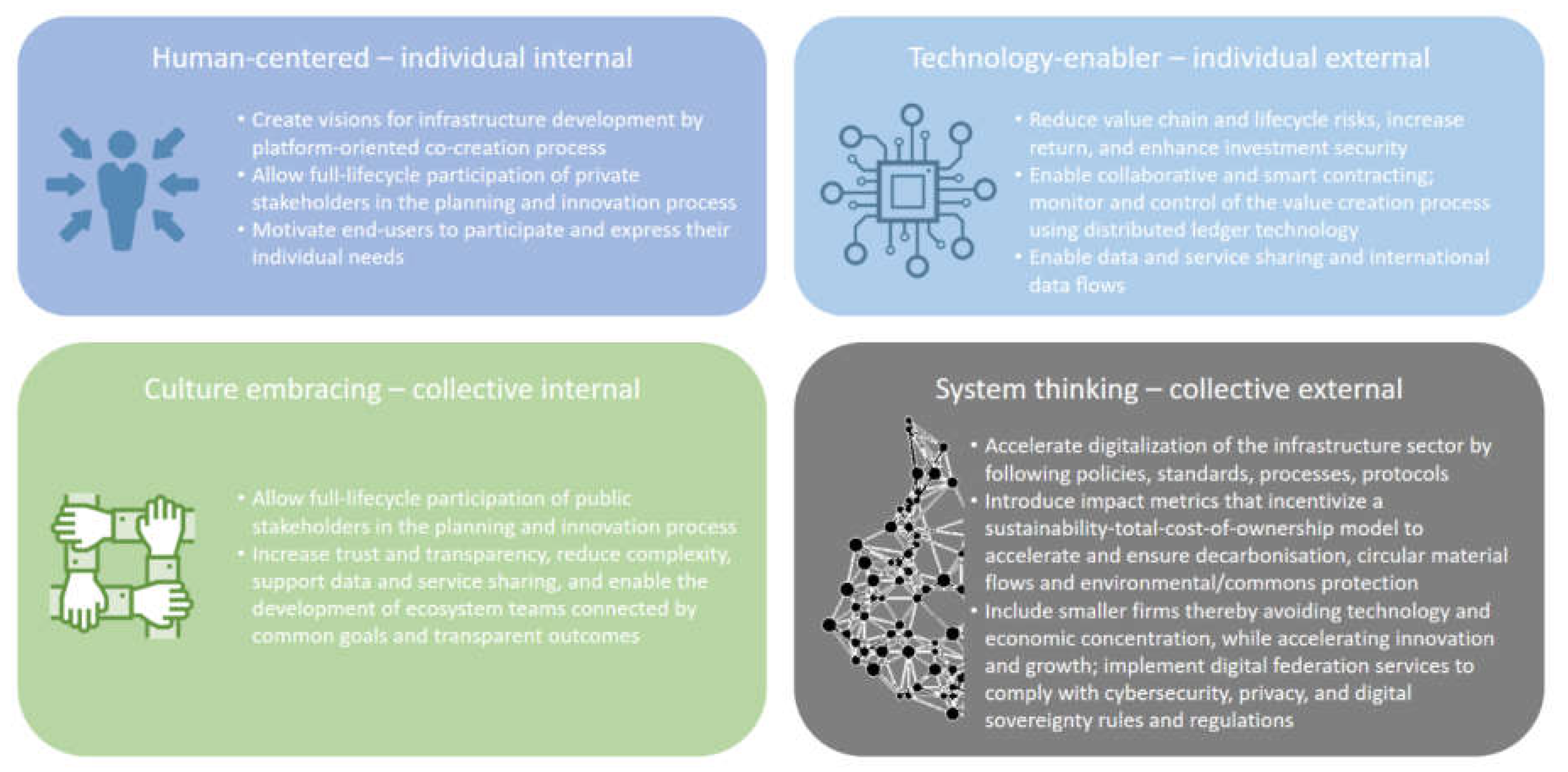
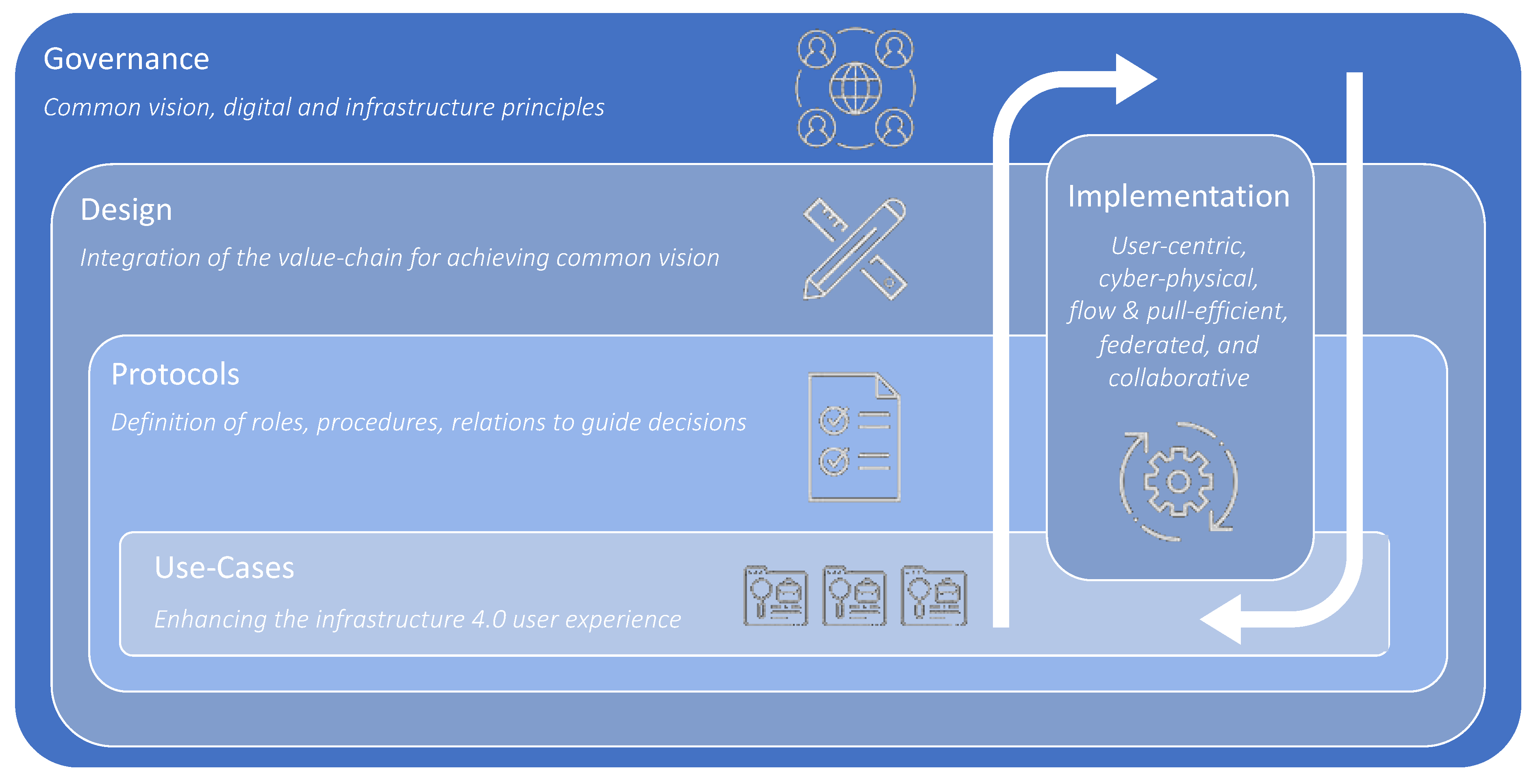
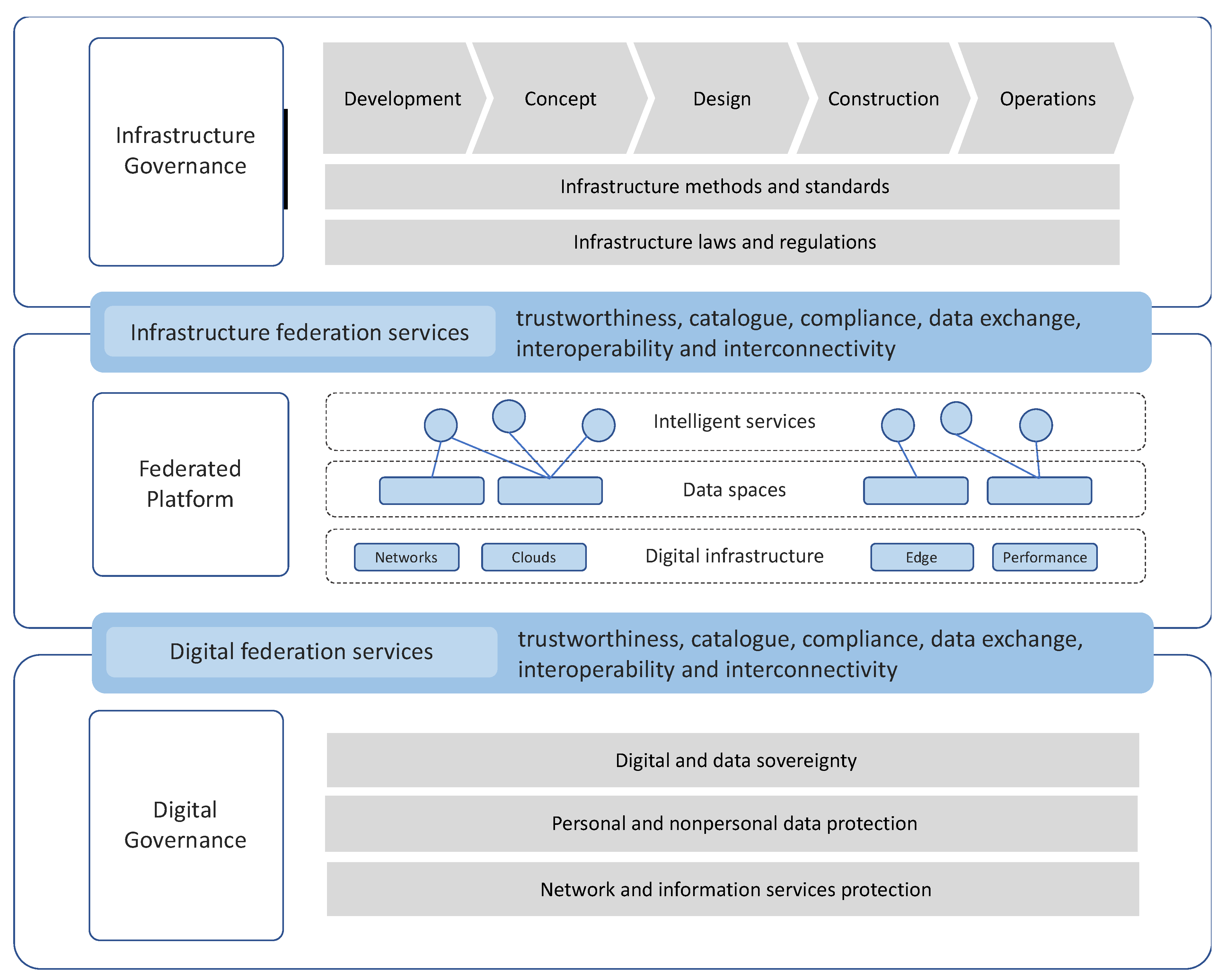
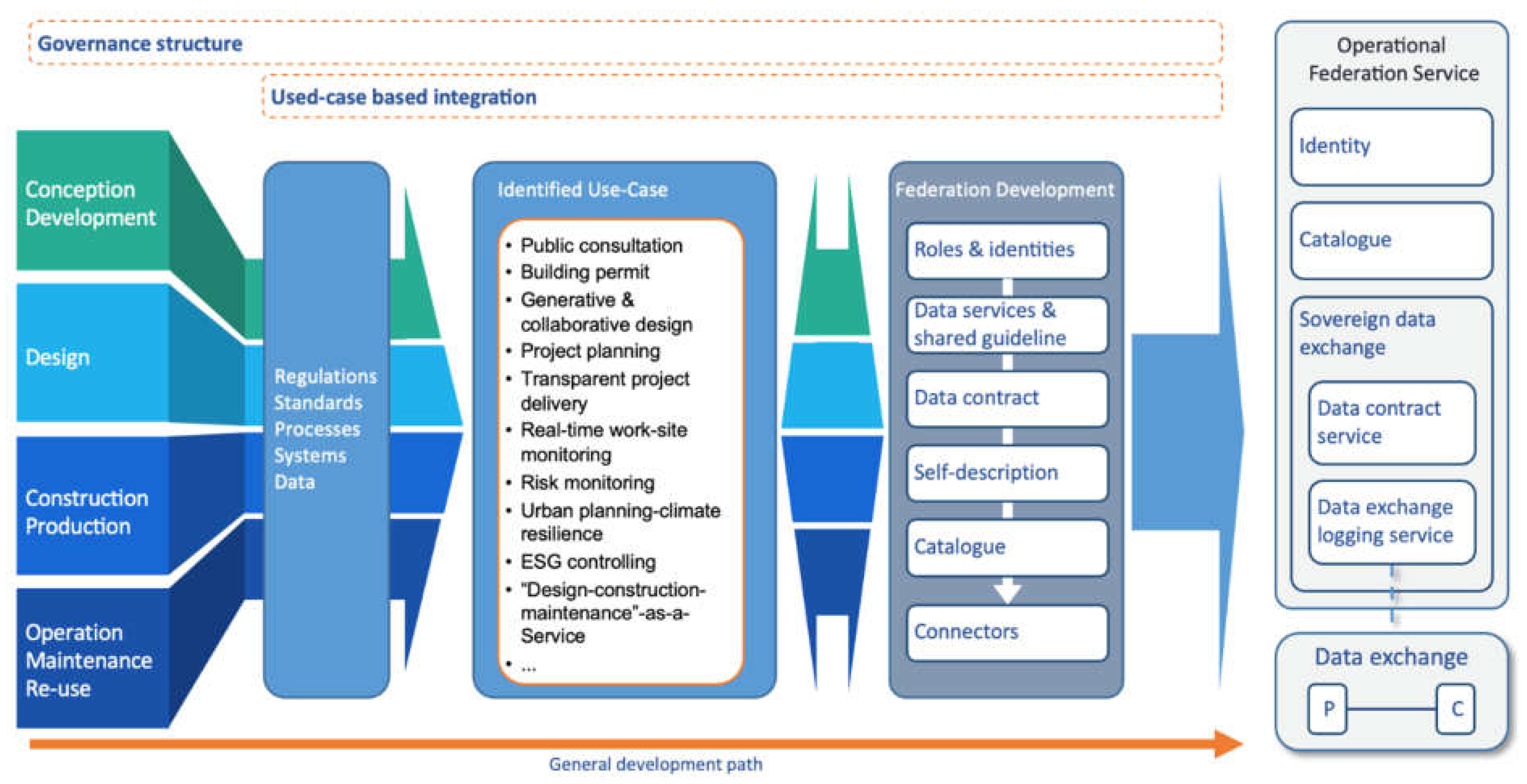
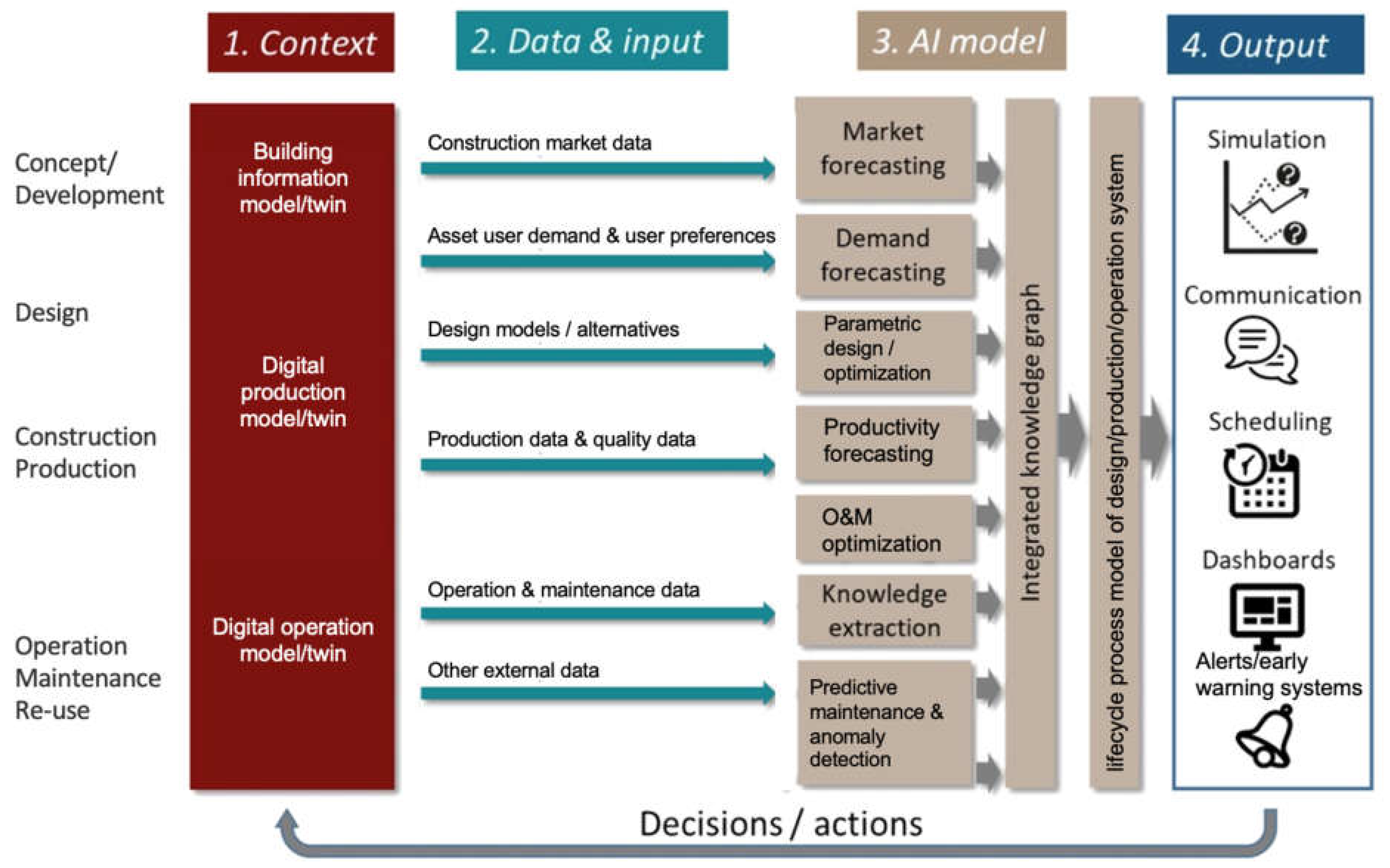

Publisher’s Note: MDPI stays neutral with regard to jurisdictional claims in published maps and institutional affiliations. |
© 2021 by the authors. Licensee MDPI, Basel, Switzerland. This article is an open access article distributed under the terms and conditions of the Creative Commons Attribution (CC BY) license (https://creativecommons.org/licenses/by/4.0/).
Share and Cite
Nübel, K.; Bühler, M.M.; Jelinek, T. Federated Digital Platforms: Value Chain Integration for Sustainable Infrastructure Planning and Delivery. Sustainability 2021, 13, 8996. https://doi.org/10.3390/su13168996
Nübel K, Bühler MM, Jelinek T. Federated Digital Platforms: Value Chain Integration for Sustainable Infrastructure Planning and Delivery. Sustainability. 2021; 13(16):8996. https://doi.org/10.3390/su13168996
Chicago/Turabian StyleNübel, Konrad, Michael Max Bühler, and Thorsten Jelinek. 2021. "Federated Digital Platforms: Value Chain Integration for Sustainable Infrastructure Planning and Delivery" Sustainability 13, no. 16: 8996. https://doi.org/10.3390/su13168996
APA StyleNübel, K., Bühler, M. M., & Jelinek, T. (2021). Federated Digital Platforms: Value Chain Integration for Sustainable Infrastructure Planning and Delivery. Sustainability, 13(16), 8996. https://doi.org/10.3390/su13168996








